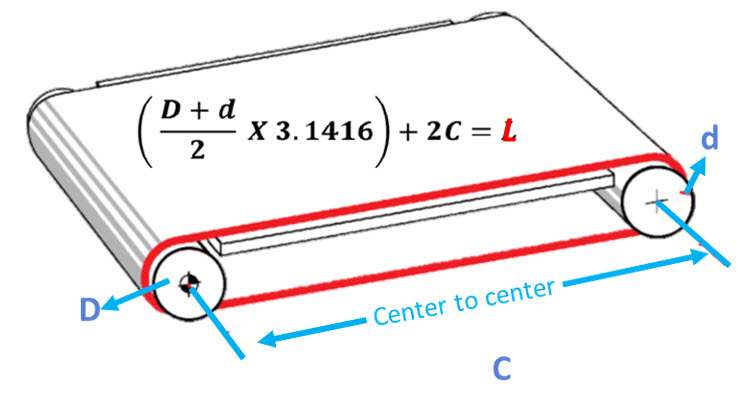Conveying Solutions
CALL US TODAY:
(800) 684-2358
- About
- Products
- Fabrication
- Services & Repairs
- Industries
- Resources
- Contact
- Belt Power Site
When it comes time to replace a conveyor belt, you could simply cut the old belt, remove it from the machine, lay it out flat, and measure it with a tape to determine the pre-tensioned length. Of course, that would entail significant downtime, putting the conveyor out of commission until you can order and receive the new belt. Chances are, this method is not an option. You want to order your replacement belt before the old one fails, and you want to install the new belt immediately after removing the old one. It pays to know how to measure a conveyor belt while it’s still on the conveyor system using the center-to-center distance formula.
This conveyor belt measurement formula is one of the most reliable methods for determining the correct length of the replacement conveyor belt you need. The formula’s name refers to the distance between the centers of your conveyor’s drive and tail pulleys. Here’s the formula:
Note: This formula can ONLY be used on 2 pulley systems

The math is not as difficult as it appears. Here’s the logic behind the center-to-center distance formula:
This calculation will yield the belt’s stretched length. Make sure to take note of where the take-ups on your system are located. If take-ups are maxed out you might what to adjust them to the center location and remeasure your center-to-center distance. This will allow for adjustment after the belt is running.

Many customers have a hard time determining the belt length after making adjustments to their take-up assemblies. There is a simple way to calculate the belt length change after take-up adjustment. But first, you’ll need to address this question: Are you adding or subtracting belt length? If you are moving the take-up towards the end of the conveyor, then you’ll be adding to the existing belt length. If you are moving the take-up towards the center of the conveyor, then you’ll be subtracting from the existing belt length (see diagram above).
(2X) +/- L1 = L2

Note: You’ll just need to double the take-up adjustment distance (X) and add/subtract that number to original belt length.
Example:
In the case of having more than 2 pulleys, the best method to get the belt length is to use the “start and stop” technique. With this method you will need to start by marking the top side of the belt with a starting mark and labeling it “0”. Find the furthest distance down the belt you are able to access and make another mark on the topside of the belt. Measure the distance between the two marks, jog the system until the second mark is in the location of the first “0” mark, then make your third mark down the length, and then measure in-between the marks again. Continue this process until your final measurement ends with the mark labeled “0”. Once you have the measurements between all your marks, add them together and you’ll discover the length of your conveyor belt.
Note: This process usually requires two people. Make sure all hands, pens, and measurement devices are off the belt before you jog the system.
Incorrectly measuring the center-to-center distance or pulley diameter, applying the wrong tensioner or prestress amounts, or making mathematical errors will result in a flawed belt length calculation. The implications of ordering the wrong belt dimensions are very serious:
Consequently, it’s critical to double and triple-check all your measurements and calculations to ensure you receive a belt with the proper specifications to keep your operations running smoothly and efficiently.
Accurate Industrial’s fully certified technicians have decades of experience fabricating precision belts. We will work with you to design and engineer custom conveyor solutions for even the most challenging production configurations. We are your complete conveyor solutions provider, supplying safe, reliable, efficient conveyor belts for lightweight operations across multiple industries as well as heavy-duty applications such as mining, agriculture, bulk handling, and more.
If you need help calculating the length of your replacement conveyor belt, Accurate Industrial’s experts can walk you through the process. Fill out our request form to receive a belt quote. If you have additional questions, call us at call us at (800) 684-2358
